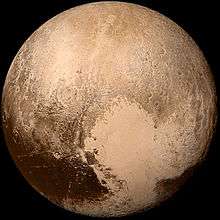(230965) 2004 XA192
| Discovery | |
|---|---|
| Discovered by | Palomar |
| Discovery date | 12 December 2004 |
| Designations | |
| SDO (near or extended)[1] | |
| Orbital characteristics[2] | |
| Epoch 13 January 2016 (JD 2457400.5) | |
| Uncertainty parameter 3 | |
| Observation arc | 9268 days (25.37 yr) |
| Aphelion | 58.967 AU (8.8213 Tm) |
| Perihelion | 35.465 AU (5.3055 Tm) |
| 47.216 AU (7.0634 Tm) | |
| Eccentricity | 0.24888 |
| 324.44 yr (118503 d) | |
| 356.376° | |
| 0° 0m 10.936s / day | |
| Inclination | 38.07711° |
| 328.7517° | |
| 132.632° | |
| Earth MOID | 34.588 AU (5.1743 Tm) |
| Jupiter MOID | 30.7418 AU (4.59891 Tm) |
| Jupiter Tisserand parameter | 4.703 |
| Physical characteristics | |
| Dimensions |
339+120 −95 km[3] |
| 7.88 h (0.328 d) | |
Sidereal rotation period | 7.88 [2] |
| 19.84 [4] | |
| 4.1[2] | |
|
| |
(230965) 2004 XA192 is a Kuiper-belt object with a diameter of 339+120
−95 km. It has an absolute magnitude of 4.11. It was discovered on 12 December 2004 at Palomar Observatory.
It is currently at 35.8 AU from the Sun, near its perihelion.[5]
References
- ↑ Marc Buie (2014-08-23). "Orbit Fit and Astrometric record for 230965". SwRI (Space Science Department). Retrieved 2014-11-14.
- 1 2 3 "JPL Small-Body Database Browser: 230965 (2004 XA192)" (2011-11-22 last obs; arc: 22.23 years). Retrieved 11 April 2016.
- ↑ TNOs are Cool: A survey of the trans-Neptunian region. X. Analysis of classical Kuiper belt objects from Herschel* and Spitzer observations p. 18
- ↑ 0 & n = 230965 AstDys Summary for (230965) 2004 XA192 Retrieved 31 August 2009
- ↑ AstDys Ephmerides for (230965) 2004 XA192, Retrieved 31 August 2009
External links
- Chart Trajectory by JPL (software needs JAVA)
- (230965) 2004 XA192 at the JPL Small-Body Database
This article is issued from Wikipedia - version of the 4/11/2016. The text is available under the Creative Commons Attribution/Share Alike but additional terms may apply for the media files.
_(cropped).jpg)
